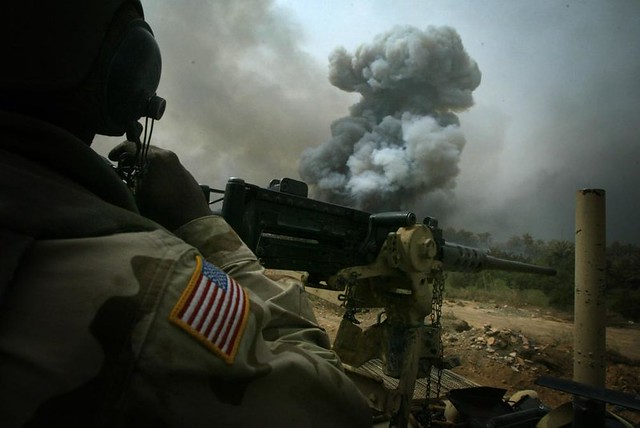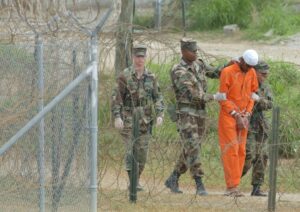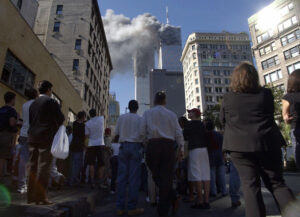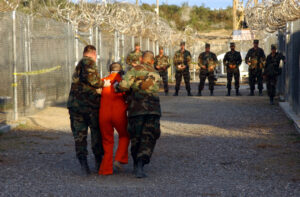Why Won’t the Mainstream Media Acknowledge Our Forever Wars?
A recent factcheck of 2020 Democratic hopeful Beto O'Rourke lays bare the political press' abject failure in covering conflicts like Iraq. Noticias Virtuales / Flickr
Noticias Virtuales / Flickr
Taking a country to war is the most consequential step political leaders can take. So it would follow that a free press tasked with holding political leaders accountable for such a fateful decision would exercise the utmost scrutiny when it comes to reporting on the costs—both financial and human.
This necessarily rigorous journalistic oversight should never be satisfied with repeating vague claims of progress or accepting easily contradicted evidence about having achieved peace. Literal human lives, both civilian and military, hang in the balance, and so as a war drags on, it becomes increasingly important for a free press to avoid complacency and ruthlessly interrogate the facts on the ground.
Tragically, coverage of US military combat in Iraq offers an untold number of examples where the corporate press spectacularly failed to live up to this critical responsibility. Whether it was the unabashed cheerleading that colored much of the reporting during the first Gulf War (Extra!, 4/91) or the credulous parroting of false WMD claims in the lead-up to the 2003 re-invasion—with the New York Times earning special condemnation (FAIR.org, 7/21/16)—the US media has compiled a dreadful record when it comes to Iraq.
And, true to form, in the past two weeks we’ve see another, less monumental but still insidious, case of inaccurate Iraq war coverage. Coincidentally, this latest mistake comes courtesy of corporate media’s “factchecking” structure.
It all stems from a comment by Democratic presidential candidate Beto O’Rourke, who has begun inserting a critique of our country’s endless war posture into his stump speeches. At his campaign launch in February, and in several public appearances since, he has commented along these lines (from a March 30 speech):
Do we really want to fight wars forever? Twenty-seven years in Iraq, 18 years, almost, in Afghanistan and counting, with no definition or strategy or end in sight. Trillions of dollars we are spending to fight and to rebuild countries that we’ve invaded.
While the claim of 18 years of military combat in Afghanistan is incontrovertible, some in the press pounced on O’Rourke’s description of an Iraq war that is “27 years and counting.” The Associated Press (4/2/19) drew first blood. In a long factcheck of false statements by Trump, writers Hope Yen, Calvin Woodward and Eric Tucker incongruously wedged in a critique of O’Rourke’s 27 years claim, flatly declaring that he had “misstated the length of the US involvement in the Iraq War.”
This kind of forced false equivalence in factchecking is not new. FAIR (12/7/19) has previously demonstrated how traditional news orgs, already awash in a sea of Trump’s dishonesty, often contort themselves to shoehorn supposedly false comments by left-of-center politicians into the voluminous coverage of the president’s many lies and distortions.
Not to be outdone, the Washington Post (4/9/19) also took O’Rourke to task for his “27 years and counting” claim. Writing in his Fact-Checker column, Glenn Kessler said “O’Rourke’s math for the Iraq War left us flummoxed.” Parsing what he asserts were the begin and end states of US military combat in Iraq, Kessler rests his main objection on the 12-year interregnum between the end of coalition ground hostilities in the first Gulf War in late February 1991 and the second US ground invasion in March 2003. Giving O’Rourke “Three Pinocchios,” Kessler concluded:
There are three, or maybe four, points at which the United States can be labeled as fighting in Iraq in the past three decades. But there has not been a continuous war.
This is, simply put, not true. But it offers a clear tell to how corporate media have grown inured to nearly two generations of US military combat in Iraq, and increasingly normalized our nation’s violent power projection around the world.
In fact, the end of ground hostilities in 1991’s Operation Desert Storm merely marked a transition to a new kind war in Iraq: a US/UK air combat occupation known in military parlance as operations Northern and Southern Watch. This “no-fly zone” covered more than half of Iraq’s total airspace, and lasted from the end of the 1991 Gulf War right up until the March 2003 invasion. Nevertheless, Kessler quickly glosses over this period in two paragraphs, briefly mentioning 1998’s Desert Fox cruise missile attack on Iraq, but then archly concludes: “But no troops entered Iraq in this period.”
This is a chilling and astoundingly outdated calculus by Kessler. (The AP avoided this particular mistake by failing to mention the 12-year no-fly zone altogether—an even more stunningly negligent oversight.) War is not simply defined by the presence of infantry soldiers maneuvering over foreign terrain. Taking control of another country’s airspace with armed aircraft is no less an act of war than implementing a naval blockade of a country’s ports.
But don’t just take my word for it. Here’s the NATO Supreme Allied Commander Gen. Phillip Breedlove saying the exact same thing back in 2013 , when US politicians like Sen. John McCain began calling for a no-fly zone over parts of Syria in the early stages of that country’s horrible civil war: “It is quite frankly an act of war and it is not a trivial matter,” he told Stars & Stripes (5/31/13).
And even though the Iraq no-fly zones were ostensibly a continuation of UN Resolution 688, that doesn’t make them any less of a form of combat operations. UN-sanctioned war is still war.
Indeed, to read this public report from the UK National Archives is to get much better grasp of the deadly consequences of the US/UK no-fly-zone operations. From just 1991 to 1993, the report noted at least five separate air combat incidents:
The first two years involved relatively routine patrolling of the no-fly zone, although two Iraqi fighters were shot down and elements of Iraq’s ground based air defen2e system posing a threat were attacked in three incidents in December 1992 and January 1993.
During the last of these series of US/UK attacks—a strike against Iraqi intelligence headquarters in retaliation for an alleged assassination plot to kill President George H.W. Bush—nine civilians were reportedly killed and 12 more were wounded by an errant coalition missile. In September 1996, the allied coalition also launched two separate cruise missile attacks into Iraq, in response to an Iraqi army incursion against Kurds in northern Iraq.
Then, in December 1998, the US and Britain launched Operation Desert Fox, after Iraq refused to comply with UNSCOM inspections at a few sensitive sites, although, contrary to many subsequent, erroneous press reports, Iraq did not expel the inspectors from the country (FAIR.org, 3/6/00).
Though Kessler does mention Desert Fox as “four-day bombing campaign” in his column, he left out all the details and key context of the scale of what was involved. According to the UK archives, in Desert Fox:
US and UK forces used over 400 cruise missiles (more than in the 1991 Gulf Conflict) and 218 tactical bomber sorties to attack 100 targets, including:
- sites identified as being involved in Iraq’s weapons of mass destruction programs;
- command and control facilities through which Saddam controlled military and internal security forces;
- the Iraqi Republican Guard;
- the Iraqi air defense system;
- airfields, including those associated with helicopter forces used for internal repression.
While no specific figures exist for Iraqi military personnel killed by Desert Fox, various contemporaneous reports put the civilian casualty total at several hundred, with around 60 to 70 killed. In the wake of this carnage, Iraq summarily refused to accept the continued no-fly zone patrols, and for the next five years resisted this air occupation with repeated combat responses, as the UK report points out:
Coalition aircraft were fired at by Iraqi surface-to-air missiles and anti-aircraft artillery or targeted by fire control radars. In responding to this threat, coalition aircraft targeted a variety of different elements of Iraq’s Integrated Air Defense System, such as radar sites and associated communications and control networks, surface-to-air missile batteries and anti-aircraft artillery positions. RAF Jaguars flying reconnaissance operations in the northern no-fly zone did not carry or drop air-to-ground ordnance, but RAF Tornado aircraft did so in the southern no-fly zone on numerous occasions.
During the more than 12 years of air patrols over Iraq, the US alone averaged more than 34,000 annual military sorties, according to the Washington Institute for Near East Policy. And an October 2002 Congressional Research Service report calculated that the total costs of these two massive, ongoing no-fly zone operations came to more than $10 billion.
All of these attacks and untold number of deaths does not rise to the definition of war to the Post’s Kessler or to the AP. This is both historical and journalistic malpractice—and the furthest thing from accurate, contextual factchecking.
One wonders if these two news organization would so cavalierly dismiss, if not wholly disappear, Russian or Chinese fighter jets patrolling the eastern half of the United States and occasionally shooting down our military aircraft or bombing our air defense systems. Of course, the question answers itself.
Kessler also subtracts the nearly three years, from 2012 to late 2014, when regular US ground combat units were absent from the country. Once again, though, having regular troops on the ground is not the definition of being engaged in combat. In fact, one US soldier was still killed by hostile fire during this period, according to iCasualties.org. Furthermore, a Post report (4/17/16) noted that US special operations advisors had remained in northern Iraq from the claimed end of combat hostilities in 2011 right up through the ISIS takeover of Mosul in 2014.
But what’s even more inexplicable is that Kessler brushes aside an admission by the US military itself that our country has been in continuous combat operations since the first Gulf War. In his column, Kessler included this defense of the 27 years claim by an O’Rourke campaign aide:
Evans said O’Rourke’s remarks were inspired by Gen. Stephen W. Wilson, the Air Force’s vice chief of staff, who came before the House Armed Services Committee on October 3, 2017, and stated: “The 26 years of continuous combat has limited our ability to prepare . . . against advanced future threats. Scenarios with the lowest margin of error and the highest risk to national security. This nonstop combat, paired with the budget instability and lower than planned top lines, has been the United States Air Force, the smallest, oldest equipment and least ready in our history.”
If anything, one could argue O’Rourke is slightly too low, and that 28 years and counting would be more accurate. But Kessler effectively dismisses this testimony, in a classic case of “Who are you going to believe: Me or your lying eyes?” and instead sides with a handful of former Bush and Obama White House officials who say otherwise. His verdict for O’Rourke: “Three Pinocchios,” his column’s second-highest rating for rhetorical dishonesty.
For context, here are some other, recent “Three Pinocchio” fact-checks from the Washington Post, for comparison:
- Trump’s claim that his daughter Ivanka has created “millions of jobs” (2/27/19)
- GOP Rep. Liz Cheney’s claim that the Green New Deal would “eliminate air travel” (2/14/19)
- Vice President Pence’s claim that the Trump administration “has stood strong for a free and independent press and defended the freedom of the press on the world stage” (11/20/18)
The absurdity on offer here by the Post (and the AP) is obvious, but it’s also symbolic of corporate media’s broader bias in war coverage toward US military adventurism, and the institutional timidity that it creates. In a way, O’Rourke’s scathing critique of the excessively violent nature of US foreign policy for the past three decades also contains an implied condemnation of the media that have enabled this endless war posture. After all, you’ll never succeed in holding politicians accountable for flawed wars if you can’t recognize what war looks like in the first place.
Your support matters…Independent journalism is under threat and overshadowed by heavily funded mainstream media.
You can help level the playing field. Become a member.
Your tax-deductible contribution keeps us digging beneath the headlines to give you thought-provoking, investigative reporting and analysis that unearths what's really happening- without compromise.
Give today to support our courageous, independent journalists.






You need to be a supporter to comment.
There are currently no responses to this article.
Be the first to respond.